Trees Birds Mammals Fish Amphibians Reptiles
Wild Algarve
Bookshop
Fomes fomentarius (L. ex Fr.) Kickx- Hoof Fungus
Phylum: Basidiomycota - Class: Agaricomycetes - Order: Polyporales - Family: Polyporaceae
Distribution - Taxonomic History - Etymology - Identification - Culinary Notes - Reference Sources
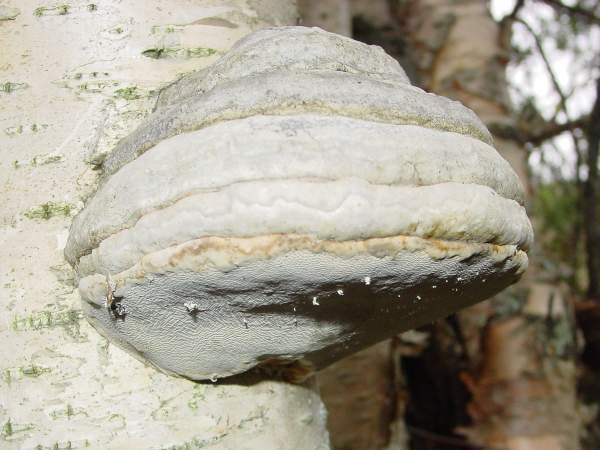
Tinder Fungus and Hoof Fungus are two common
names for the persistent, tough polypore Fomes fomentarius. This
large bracket fungus attacks mainly birch but occasionally beech and sycamore. The pale leather-brown flesh was used for lighting fires (it burns very slowly); for this reason it was
given the name Tinder Fungus.
Distribution
Rare in southern Britain and Ireland; common in Scotland and northern mainland Europe.
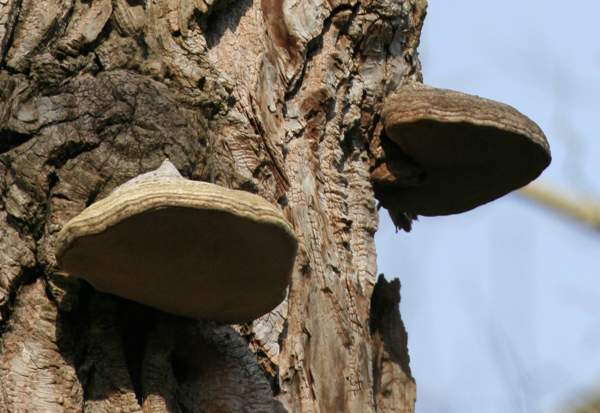
Trout fishers use to carry chunks of dried Hoof Fungus, with which they
would dry their artificial flies to make them float. Called 'amadou', the material
was specially treated and had the reputation of acting as a very effective
desiccant.
This is one of the bracket fungi found among the possessions of Otzi the Iceman, a 5000 year old man whose body was preserved in a glacier in the Ötztal Alps on the border between Austria and Italy, where it was discovered by hikers in 1991. It seems likely that Otzi was carrying this material in order to light a fire at the close of a day whose end he did not live to see.
Otzi's mummified corpse is currently on display at the purpose-built South Tyrol Museum of Archaeology in Bolzano (South Tyrol, Italy).
The brackets of Hoof Fungus shown above were growing on an ailing poplar tree in southern France. Poplars can live for several years with this fungal attack, but gradually the trees are weakened until they can no longer survive. Soon after a tree dies the brackets of Hoof Fungus cease growing, but they can remain and attached to the dead trunk intact for a year or more.
The dark Hoof Fungus below was growing from a fallen Silver Birch in Cambridgeshire, England.
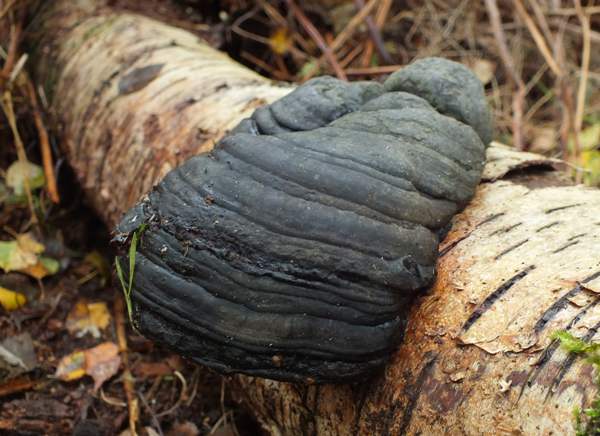
Taxonomic history
As you might expect with such a common and conspicuous bracket fungus, Hoof Fungus did not escape the notice of Carl Linnaeus, who described it scientifically in 1753 and gave it the name Boletus fomentarius. In 1821 Elias Magnus Fries endorsed the basionym, renaming this bracket as Polyporus fomentarius. The new genus Fomes was erected by Fries in 1849, and the Flemish mycologist Jean Jacques Kickx (1842 - 1887) transferred Hoof Fungus to that genus in 1867, thus establishing its currently-accepted scientific name as Fomes fomentarius.
Synonyms of Fomes fomentarius therefore include Boletus fomentarius L., and Polyporus fomentarius (L.) Fr.
Fomes fomentarius is the type species of the Fomes genus.
Etymology
Fomes, the generic name, comes from Latin and means 'tinder', and rather tautologically the specific epithet fomentarius translates to 'used for tinder'.
Identification guide
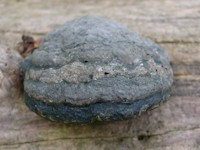 |
Fruitbody
This sombre fungus usually appears as a solitary specimen
but occasionally two or more tiers are produced.
On standing timber this bracket sometimes gains a hold in clefts in the
trunks of older trees; however, the aged specimen shown on the left was found on a fallen
beech tree. |
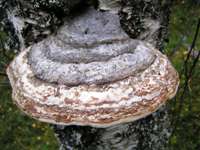 |
Annual layers of tubes
build up to produce a large hoof-shaped structure 10 to 40cm across and
up to 20cm deep at the centre of the attachment line. After the first three or four years, brackets increase steadily in thickness but do not grown much in diameter - hence the resulting hoof shape.
The upper infertile surface is various shades of grey, often with a brownish growing zone towards the outer edge. The lower (fertile) surface is white or greyish, turning slightly brown when bruised. |
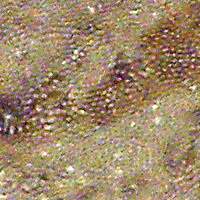 |
Pores and Tubes
Inside the fruitbody the flesh is hard and
pale brown, while the tubes are pale
grey-brown at first but become darker brown with age. The pale spore-bearing surface is noticeably softer and has minute pores typically spaced at 2 to 3 per mm. |
| |
Spores
Oblong-ellipsoidal, smooth, 15-20 x 5-7μm.
Spore print
Very pale lemon. |
Odour/taste |
The odour is faintly fruity; the taste acrid. |
Habitat & Ecological role |
Parasitic on broadleaf trees, particularly birch and less often beech
and sycamore, but continuing to grow for many months as a saprobe on dead/fallen trunks. I have just once seen Hoof Fungus on a Cork Oak, and that was in the Algarve region of southern Portugal. |
Season |
Present all year round; shedding spores in late spring and summer. |
Similar species |
Could be confused with some of the Ganoderma bracket fungi, although they
release brown spores; also possibly with Piptoporus betulinus, the
Birch Polypore, an annual bracket which has a much smoother upper surface. |
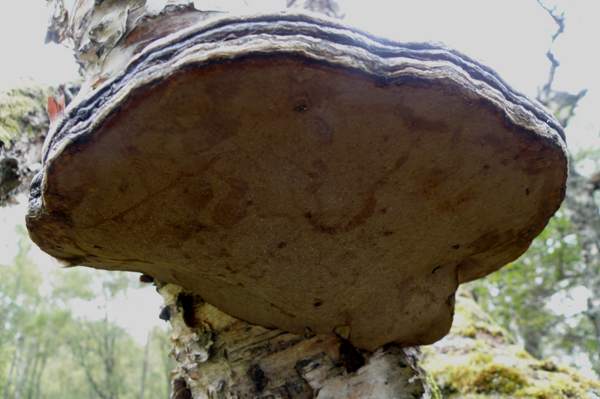
Culinary Notes
These bracket fungi are far too tough to be edible.
Reference Sources
Mattheck, C., and Weber, K. Manual of Wood Decays in Trees. Arboricultural Association 2003.
Pat O'Reilly, Fascinated by Fungi, 2016.
Dictionary of the Fungi; Paul M. Kirk, Paul F. Cannon, David W. Minter and J. A. Stalpers; CABI, 2008
Taxonomic history and synonym information on these pages is drawn from many sources but in particular from the British Mycological Society's GB Checklist of Fungi.
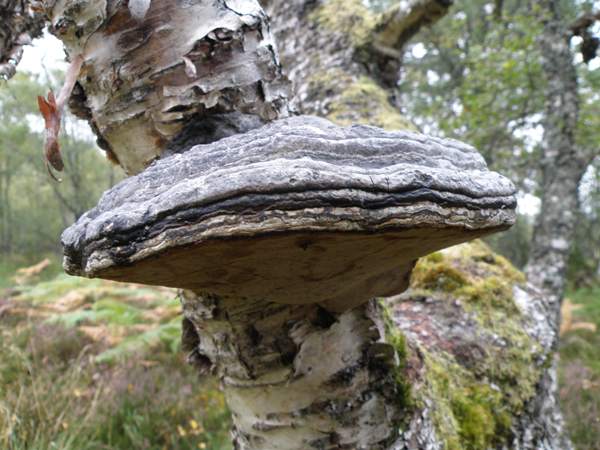
Top of page...
Fascinated by Fungi. Back by popular demand, Pat O'Reilly's best-selling 450-page hardback book is available now. The latest second edition was republished with a sparkling new cover design in September 2022 by Coch-y-Bonddu Books. Full details and copies are available from the publisher's online bookshop...